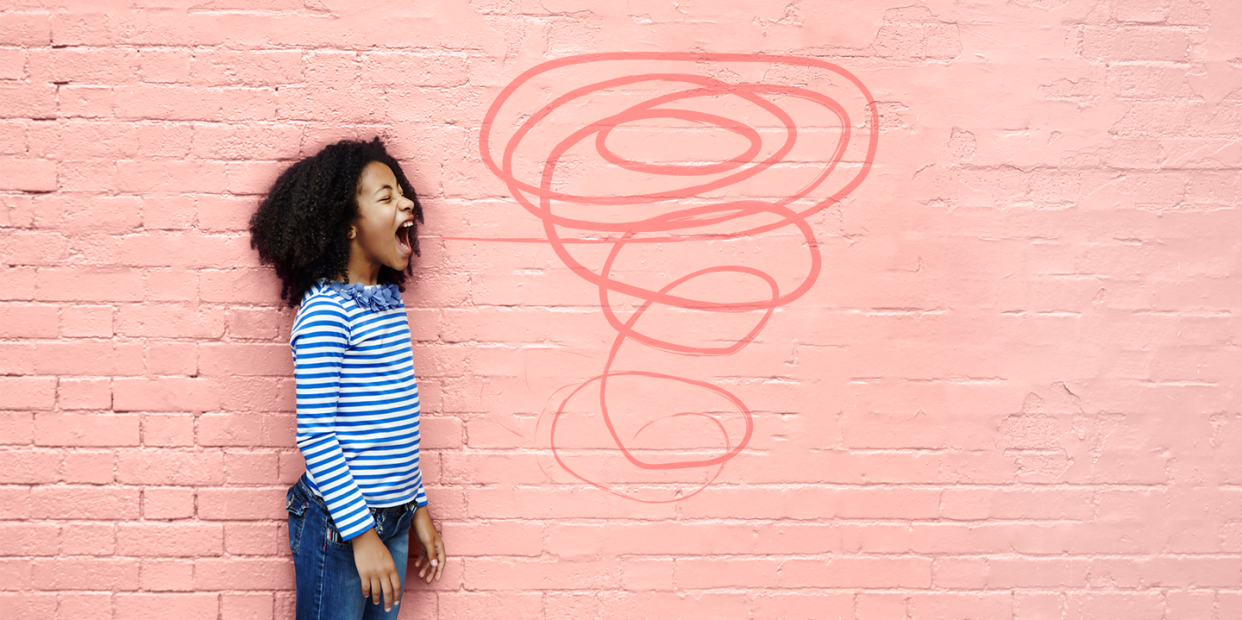15 Ways Parents Can Help Children Navigate Overwhelming Stress Right Now

We all must have missed this chapter in the parenting manual. You know, the one that tells us how to help our children understand and deal with a sudden pandemic, school on a screen, exposure to upsetting news and images of racial injustice and protests, and political upheaval — not to mention having to stay away from Grandma and Grandpa for the time being. Welcome to 2020, with parents and kids alike scrambling to adapt to a world in which the ground seems to be constantly shifting. Seriously, what do you do when your 8-year-old tries to construct a ladder so he can climb over the fence to escape quarantine, as one mom told us her son did? And how, as one dad asked on social media, do you soothe an 8-year-old who wonders aloud whether his family is going to become enslaved again?
“We’re all trying to adapt and explain it to our kids, but it’s so hard,” says Tasha Brown, Ph.D., a child psychologist in New York. “Parents are stressed, and kids are stressed too.” The truth is, while you can’t shield them entirely, you can help them feel more secure. Whether it’s explaining to a toddler why everyone has their smile covered by a mask or to older kids about marchers in the streets, putting what they see into context will add to their sense of safety. “Tell them that this is all happening because people are trying to create a world that is safe for everyone,” Brown says.
Below, a panel of experts assembled by Good Housekeeping weigh in on what children of different ages actually need during these times of turmoil.
Every parent should:
Follow their lead. One 10-year-old might be concerned about whether sports will begin in the fall while another may want to talk about Breonna Taylor. A kindergartner may be extra fearful of germs while her twin sister is just thrilled that her mommy is home so much. “Your child’s maturity level, exposure and environment all play a role in where they are developmentally,” says Brown. Here, parents should always be asking questions to determine how to steer the conversation: What are you thinking about? What have your friends been talking about? Is there anything you want to ask? “Let their questions guide you,” says Brown. “That helps you gauge where they are and what they need to know.”
Stick to a schedule. While the outside world is unpredictable, you can provide stability by sticking with a routine. “Consistency and structure help kids feel like the world is OK,” says Wanda Vargas-Haskins, Ph.D., a child and family trauma therapist in New York City. You may even want to spend some time crafting a visual schedule with your little one. For younger kids, it can help to draw pictures to create a visual schedule of mealtime, nap time, playtime and calls with grandparents. For older kids, waking up and going to bed at the same time daily and eating meals as a family make home life predictable.

Block out one-on-one time. Between work calls, virtual school and everyone disappearing into their devices, plain old fun as a family may get shelved. "It feels like I’m rejecting my 3-year-old when he comes in to snuggle, and I have to explain that I have to work," says Monica Stephens, who’s working at home in Buffalo without child care. Try to block out half an hour of uninterrupted time each day and let your child choose the activity. For a toddler, that may mean reading and snuggling, whereas a 12-year-old may want to go for ice cream or play Mario Kart. “The quality of the time is more important than quantity,” says Vargas-Haskins.
Take care of yourself. Even babies can sense a parent’s anxiety, says Vargas-Haskins. You should absolutely not pretend that everything is dandy, but alleviate your own stress so you can be as present as possible when taking care of kids is important. It’s OK to hide in the bathroom for 15 minutes to listen to music or let the kids binge-watch PAW Patrol while you unwind with friends over Zoom. Do so without guilt. “You’re setting an example for your kids that self-care is really important,” says Brown.

For very-littles, home and family are their entire lives. These years are foundational in terms of understanding relationships and forming attachments to caregivers, says Vargas-Haskins. They’re figuring out how to socialize as well as noticing differences in gender and skin color — it’s never too early to start talking about fairness, kindness and empathy. And while they may not know about the pandemic or inequality, they may be missing their teachers at preschool or wondering where a relative who passed away has gone.

Help them identify their emotions. Meltdowns are totally normal when a little kid is cooped up, and naming feelings is a powerful way to bring them down to size, says Vargas-Haskins. You should actively try and suss out why your little one is having trouble currently: “Say, ‘Mommy’s thinking maybe you’re having big feelings. Are you scared about something? Are you remembering something you’re upset about?’ They may not have an answer, but that opens the door to thinking about their behavior,” Vargas-Haskins says. This will also teach self-awareness so they can respond appropriately instead of letting emotion overwhelm them. You can help by naming your own emotions and describing what you’ll do to make yourself feel better.
Let them process their emotions through play. When social distancing was at its peak, Rebecca Buczak of Hamburg, New York, found that her three kids, ages 5 and under, were making forts all over the house. “The more I thought about it, the more I realized they were building safe places,” she tells Good Housekeeping. When children this age are experiencing drastic change, it’s common for them to figure things out through games and make-believe, says Jacqueline Faison, Ph.D., a child and trauma therapist in New York City. “Play is just such a big part of how children express themselves and communicate worries, fears and other feelings,” she says. Be sure to ask yourself if the way they’re playing is normal for them. If you see something upsetting, like a child using dolls to act out conflict in unkind ways, gently ask what they’re playing and why. If this kind of play is atypical for them, it may be a sign of a deeper stress.
Be honest, but keep things simple. Caitlin Keryc, of New York City, has a 4-year-old daughter who is biracial. “My husband and I have always talked to her about racism in ways she has been able to start to process over time,” she says. “She knows George Floyd was hurt by police. My husband and I stand by transparency, remaining calm and talking about actions we can take to be part of the solution.” Don't skirt any issues in your household: “Talking about treating all people fairly is something even younger kids understand,” says Brown.
Your kids were getting into the groove of school and learning independence from you, and then, boom — they were home and away from their pals and favorite teachers. This and other stresses might set them back developmentally for a time. “You might see crying, clinging to parents, sadness or tantrums,” says Melissa Robinson-Brown, Ph.D., the owner of Renewed Focus Psychology Services in New York City. They might withdraw or refuse to do things you ask of them. You may also notice signs of anxiety, such as fidgeting or nail biting, and they may be more aware of what’s going on than you think. “My 8-year-old daughter, Willow, really misses her friends, her nana in California and eating out at her favorite pizza place,” says Amy Miller, a mom of three in Minneapolis. “But she also knows
all about George Floyd — our entire city has been in mourning — and she has told me how sad she is for his family.”
Help them connect with friends and relatives. This will keep their spirits and social skills up. You can still facilitate a social life despite the pandemic: If health authorities say it’s safe to do so in your area, set up socially distant playdates. If you still need to stay home, “write letters to their friends or grandparents or a favorite cousin,” says Brown. They can watch movies or play I Spy with their friends over FaceTime, or record mini diary videos to share highlights of the week with loved ones, which will help them feel connected.
Keep them moving. It can be easy to fall into a routine of video games, snacks and YouTube. But exercise is as important for the brain as it is for the body. “Have them run around the backyard, or if you don’t have open space, do jumping jacks, have a dance party or try kids’ yoga,” says Robinson-Brown. “This will help get out the anxious energy.” Hide-and-seek, charades and obstacle courses are also great choices, as are walking, hiking and biking — just remain careful about masks, social distancing, and handwashing while out and about.

Don’t fear difficult topics. Sickness. Loneliness. Racism. None of these issues is easy, but Faison says showing your child that it’s all right to talk about complex things helps build trust and teaches honesty. “Tell them it’s OK to be sad, mad or worried, and be sure they know they can talk to you about those feelings,” Brown shares. Raymond J. Lee, a New York City dad, used his own illness to demystify it for his daughter. “My 6-year-old daughter, Ella, would give me the saddest faces when I had to lie down,” says Lee, who had the coronavirus in March. “Her teacher had told her class what a virus did to the body, and we were then able to teach her why it was important to wear masks, wash our hands and social distance.”
Make a zen list. Knowing their go-to soothers is a great life skill for children. Encourage your kids to come up with things that make them feel calm, like listening to music or petting the cat, says Brown. Then when you notice them feeling anxious or stressed, remind them to engage in something from their list. “Willow loves crafts, so she’s been making laminated bookmarks and sending them to friends who are lonely or sick to cheer them up, and it makes her feel better too,” Miller says.
The tween years are all about socializing, so when Amy Bleier Long’s 10-year-old told her “I’m dead inside” during quarantine, Bleier Long found the word choice surprising — but understandable. “She was feeling stressed, scared and sad because she couldn’t see her friends,” says the Manlius, New York, mom. Isolation has hit this age group particularly hard, because they’re missing not just crucial peer relationships, but also the sense of accomplishment that in-person reinforcement from teachers provides, says Sarah Nayeem, M.D., a child and adolescent psychiatrist at Nationwide Children’s Hospital in Columbus, OH.
Encourage creative expression. This will help kids process what they’re hearing as well as alleviate their boredom. Whether it's crafting or singing, painting or even cooking, most any medium will do. “I encouraged my 9-year-old, Jade, to start a pandemic journal,” says Allie Edwards, 32, of Wildomar, California. “Making it factual and studious took the fear and anxiety away. She printed out charts and graphs about the pandemic to create
a scrapbook of everything she learned. She even found positives, like fun virtual field trips and Zoom classes. She started to feel like a reporter and was studying and learning instead of fearing.”
Show them their power. Crazy and hateful things are being said on TV and social media, which can make even adults despair, but there are ways to keep perspective. “Help kids identify things they can control versus things out of their control,” says Brown. “For example, they can control their thoughts, but they can’t control other people’s actions or responses to a situation.” Let’s say another child says something hurtful: Your child can’t change the other child’s behavior, but they can try to remain kind and think about what might be going on in the other kid’s life that could be causing them to be mean. Tell them to visualize a stop sign as a reminder to pause and think before reacting.

Educate yourselves together. Having concrete information about what’s going on in the world will make both of you feel more empowered. Do a little research so you’re able to answer whatever questions your child throws at you—childmind.org is one great resource. Or look up answers together: “You know what? I don’t know why more Black people than white people are dying from COVID, but let’s read some articles together and see what the experts say.”
Lead with empathy. Encourage a sense of community even with those who think differently. “We want to equip kids with the confidence and the background to understand that we can be different and still support each other, that we can participate in positive change by listening, caring and speaking out when something is wrong,” says Dr. Nayeem. You might even start this at home by modeling an example in trying to find common ground with a relative you disagree with. If it’s safe, take kids to volunteer, perhaps collecting supplies for people in need, or to participate in a peaceful march. And keep it honest.
This special report from the Good Housekeeping Health Newsroom was produced by Marisa Cohen, Kaitlyn Pirie, Adele Jackson-Gibson, and Alyssa Jung.
You Might Also Like

 Yahoo News
Yahoo News 
